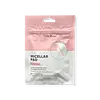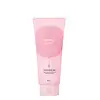What's inside
What's inside
 Key Ingredients
Key Ingredients

 Benefits
Benefits

 Concerns
Concerns

 Ingredients Side-by-side
Ingredients Side-by-side

Water
Skin ConditioningPEG-6 Caprylic/Capric Glycerides
EmulsifyingGlycerin
HumectantPropanediol
SolventPentylene Glycol
Skin ConditioningCaprylyl Glycol
EmollientHyaluronic Acid
HumectantSodium Hyaluronate
HumectantHydrolyzed Hyaluronic Acid
HumectantEthylhexylglycerin
Skin ConditioningButylene Glycol
HumectantCitric Acid
BufferingSodium Phytate
Sodium Citrate
BufferingPhenoxyethanol
PreservativeTocopherol
AntioxidantAlpha-Glucan Oligosaccharide
CleansingHydrogenated Lecithin
EmulsifyingCetearyl Alcohol
EmollientStearic Acid
CleansingPolymnia Sonchifolia Root Juice
Skin ConditioningCaprylic/Capric Triglyceride
MaskingMaltodextrin
AbsorbentCeteareth-25
CleansingCeramide NP
Skin ConditioningCetyl Alcohol
EmollientLactobacillus
Skin ConditioningCholesterol
EmollientBehenic Acid
CleansingCeramide Ns
Skin ConditioningCeramide AP
Skin ConditioningCeramide EOP
Skin ConditioningPhytosphingosine
Skin ConditioningCeramide Eos
Skin ConditioningCeramide Ng
Skin ConditioningCeramide As
Skin ConditioningCaprooyl Phytosphingosine
Skin ConditioningCaprooyl Sphingosine
Skin ConditioningWater, PEG-6 Caprylic/Capric Glycerides, Glycerin, Propanediol, Pentylene Glycol, Caprylyl Glycol, Hyaluronic Acid, Sodium Hyaluronate, Hydrolyzed Hyaluronic Acid, Ethylhexylglycerin, Butylene Glycol, Citric Acid, Sodium Phytate, Sodium Citrate, Phenoxyethanol, Tocopherol, Alpha-Glucan Oligosaccharide, Hydrogenated Lecithin, Cetearyl Alcohol, Stearic Acid, Polymnia Sonchifolia Root Juice, Caprylic/Capric Triglyceride, Maltodextrin, Ceteareth-25, Ceramide NP, Cetyl Alcohol, Lactobacillus, Cholesterol, Behenic Acid, Ceramide Ns, Ceramide AP, Ceramide EOP, Phytosphingosine, Ceramide Eos, Ceramide Ng, Ceramide As, Caprooyl Phytosphingosine, Caprooyl Sphingosine
Triethylhexanoin
MaskingGlycerin
HumectantWater
Skin ConditioningPEG-20 Glyceryl Triisostearate
EmollientButylene Glycol
HumectantZea Mays Oil
EmulsifyingCeramide AP
Skin ConditioningCeramide Ng
Skin ConditioningCeramide NP
Skin ConditioningAscorbyl Isostearate
Skin ConditioningTocopherol
AntioxidantRetinyl Palmitate
Skin ConditioningSodium Hyaluronate
HumectantPhytosphingosine
Skin ConditioningBerberis Vulgaris Fruit Extract
EmollientMalt Juice
Skin ConditioningPrunus Persica Leaf Extract
EmollientLactobacillus
Skin ConditioningAcrylates/C10-30 Alkyl Acrylate Crosspolymer
Emulsion StabilisingSodium PEG-7 Olive Oil Carboxylate
EmulsifyingSodium Stearoyl Lactylate
EmulsifyingBehenyl Alcohol
EmollientPolyglyceryl-10 Pentastearate
Skin ConditioningMaltodextrin
AbsorbentTriethanolamine
BufferingPhenoxyethanol
PreservativeParfum
MaskingCyanocobalamin
Skin ConditioningTriethylhexanoin, Glycerin, Water, PEG-20 Glyceryl Triisostearate, Butylene Glycol, Zea Mays Oil, Ceramide AP, Ceramide Ng, Ceramide NP, Ascorbyl Isostearate, Tocopherol, Retinyl Palmitate, Sodium Hyaluronate, Phytosphingosine, Berberis Vulgaris Fruit Extract, Malt Juice, Prunus Persica Leaf Extract, Lactobacillus, Acrylates/C10-30 Alkyl Acrylate Crosspolymer, Sodium PEG-7 Olive Oil Carboxylate, Sodium Stearoyl Lactylate, Behenyl Alcohol, Polyglyceryl-10 Pentastearate, Maltodextrin, Triethanolamine, Phenoxyethanol, Parfum, Cyanocobalamin
Ingredients Explained
These ingredients are found in both products.
Ingredients higher up in an ingredient list are typically present in a larger amount.
Butylene Glycol (or BG) is used within cosmetic products for a few different reasons:
Overall, Butylene Glycol is a safe and well-rounded ingredient that works well with other ingredients.
Though this ingredient works well with most skin types, some people with sensitive skin may experience a reaction such as allergic rashes, closed comedones, or itchiness.
Learn more about Butylene GlycolCeramide AP is formally known as Ceramide 6.
Ceramides are intercellular lipids naturally found in our skin that bonds dead skin cells together to create a barrier. Having a strong skin barrier leads to more firm and hydrated skin.
They are known for their ability to hold water and thus are a great ingredient for dry skin. By bolstering the skin ceramides act as a barrier against irritating ingredients. This can help with inflammation as well.
If you would like to eat ceramides, sweet potatoes contain a small amount.
Read more about other common types of ceramides here:
Ceramide NP
Ceramide EOP
Ceramide NG is a type of Ceramide. The NG stands for a sphinganine base.
Ceramides are intercellular lipids naturally found in our skin that bonds dead skin cells together to create a barrier. They are known for their ability to hold water and thus are a great ingredient for dry skin.
Ceramides are an important building block for our skin barrier. A stronger barrier helps the skin look more firm and hydrated. By bolstering the skin ceramides act as a barrier against irritating ingredients. This can help with inflammation as well.
If you would like to eat ceramides, sweet potatoes contain a small amount.
Read more about other common types of ceramides here:
Ceramide AP
Ceramide EOP
Ceramide NP
Ceramide NP is a type of ceramide and formally known as ceramide 3.
Ceramides are intercellular lipids naturally found in our skin that bonds dead skin cells together to create a barrier. They are known for their ability to hold water and thus are a great ingredient for dry skin.
Ceramides are an important building block for our skin barrier. A stronger barrier helps the skin look more firm and hydrated. By bolstering the skin ceramides act as a barrier against irritating ingredients. This can help with inflammation as well.
If you would like to eat ceramides, sweet potatoes contain a small amount.
Read more about other common types of ceramides here:
Ceramide AP
Ceramide EOP
Glycerin is already naturally found in your skin. It helps moisturize and protect your skin.
A study from 2016 found glycerin to be more effective as a humectant than AHAs and hyaluronic acid.
As a humectant, it helps the skin stay hydrated by pulling moisture to your skin. The low molecular weight of glycerin allows it to pull moisture into the deeper layers of your skin.
Hydrated skin improves your skin barrier; Your skin barrier helps protect against irritants and bacteria.
Glycerin has also been found to have antimicrobial and antiviral properties. Due to these properties, glycerin is often used in wound and burn treatments.
In cosmetics, glycerin is usually derived from plants such as soybean or palm. However, it can also be sourced from animals, such as tallow or animal fat.
This ingredient is organic, colorless, odorless, and non-toxic.
Glycerin is the name for this ingredient in American English. British English uses Glycerol/Glycerine.
Learn more about GlycerinLactobacillus is a type of bacteria with skin conditioning properties. This ingredient has antibacterial and antifungal properties (that's why we can eat fermented foods).
Learn more about the benefits of lactobacillus ferment here.
Fun Fact: Lactobacillus is used to create wine, yogurt, cheese, sauerkraut, pickles, beer, cider, kimchi, cocoa, kefir.
Learn more about LactobacillusMaltodextrin is a polysaccharide. It is derived from starch such as rice, corn, wheat, or potato starch.
In food, Maltodextrin is used to improve the texture and thicken a product. Due to its structure, it can help create a gel texture. As an emulsion stabilizer, it helps keep the ingredients in a product together.
As a polysaccharide, Maltodextrin has moisturizing properties. Polysaccharides are a type of carbohydrate. The top layer of skin uses polysaccharides to retain water, keeping the skin hydrated.
Maltodextrin is water soluble and has a sweet taste.
Learn more about MaltodextrinPhenoxyethanol is a preservative that has germicide, antimicrobial, and aromatic properties. Studies show that phenoxyethanol can prevent microbial growth. By itself, it has a scent that is similar to that of a rose.
It's often used in formulations along with Caprylyl Glycol to preserve the shelf life of products.
Phytosphingosine is a phospholipid naturally found in our skin as a building block for ceramides.. It helps moisturize, soothe, and protect skin.
Phytosphingosine contributes to your skin's natural moisturizing factor (NMF). The NMF is responsible for hydration, a strong barrier, and plasticity. Our NMF decreases with age. Increasing NMF leads to more healthy and hydrated skin.
Studies show products formulated with NMF ingredients help strengthen our skin's barrier. Having a healthy skin barrier reduces irritation and increases hydration. Our skin barrier is responsible for having plump and firm skin. It also helps protect our skin against infection, allergies, and inflammation.
Fun fact: Phytosphingosine is abundant in plants and fungi.
More ingredients that help boost collagen in skin:
Learn more about PhytosphingosineSodium Hyaluronate is hyaluronic acid's salt form. It is commonly derived from the sodium salt of hyaluronic acid.
Like hyaluronic acid, it is great at holding water and acts as a humectant. This makes it a great skin hydrating ingredient.
Sodium Hyaluronate is naturally occurring in our bodies and is mostly found in eye fluid and joints.
These are some other common types of Hyaluronic Acid:
Learn more about Sodium HyaluronateTocopherol (also known as Vitamin E) is a common antioxidant used to help protect the skin from free-radicals and strengthen the skin barrier. It's also fat soluble - this means our skin is great at absorbing it.
Vitamin E also helps keep your natural skin lipids healthy. Your lipid skin barrier naturally consists of lipids, ceramides, and fatty acids. Vitamin E offers extra protection for your skin’s lipid barrier, keeping your skin healthy and nourished.
Another benefit is a bit of UV protection. Vitamin E helps reduce the damage caused by UVB rays. (It should not replace your sunscreen). Combining it with Vitamin C can decrease sunburned cells and hyperpigmentation after UV exposure.
You might have noticed Vitamin E + C often paired together. This is because it is great at stabilizing Vitamin C. Using the two together helps increase the effectiveness of both ingredients.
There are often claims that Vitamin E can reduce/prevent scarring, but these claims haven't been confirmed by scientific research.
Learn more about TocopherolWater. It's the most common cosmetic ingredient of all. You'll usually see it at the top of ingredient lists, meaning that it makes up the largest part of the product.
So why is it so popular? Water most often acts as a solvent - this means that it helps dissolve other ingredients into the formulation.
You'll also recognize water as that liquid we all need to stay alive. If you see this, drink a glass of water. Stay hydrated!
Learn more about Water